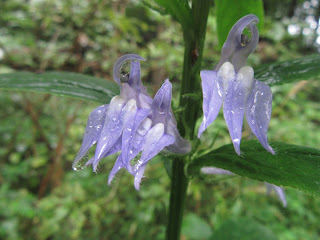Rain, Rain, Don’t Go Away
August 22, 2017
August in southern Indiana,
especially in the latter days of the month, is normally a stifling hot experience with humidity so
thick that people joke about fish swimming past them – maybe Wabash River
catfish in our area.
In 2017, that time of year was
not quite so heavy – it was pleasantly (relatively) cooler. We could be out and
about without feeling as if we were swimming.
I went down to Cottonwood Pond
on August 22 during a cloudy day, between heavy rains. The first
hard rain happened just as the Solar Eclipse ended on the 21st and
dark clouds moved in, making our area darker than it had been during our peak
97% eclipse coverage. The second heavy
rain came soon after I left the woods on the 22nd. The light was
interesting, making textures and colors stand out.
I could see the “old goblin man” clearly on
the Cottonwood’s Root Ball Bottom, his nose and eyes carved from several years
of rains, freezes and thaws that broke mud from the tangle of tree roots. The
tall greenery on the Mud Pile below gave him an exaggerated, humorous mustache
below his bulbous nose. Vines from the top draped over his forehead and eyes
like unkempt hair, and saplings had grown to tall, jaunty “feathers” on one
side of his crown.
Zooming in on the little old goblin man face ...
From this angle, above, it looks
completely different – the goblin disappears. The Root Ball has thinned
significantly over the years and, consequently, the Mud Pile has become deeper
and broader (at one time, there was Mud Pile #1 and Mud Pile #2.) It has also
become quite the foundation for plant growth. And, as mud has fallen from the
Root Ball, there have been more nooks and crannies among the exposed roots, and
more burrows made by animals that I had not yet seen.
It has become quite an
ecosystem.
Root Ball Bottom seen from the south
Animal burrows in the Root Ball Bottom
Exposed roots and webs, north edge of Root Ball
Tree saplings growing out of the southeast end of the Root Ball Top
Root Ball Bottom, Mud Pile covered by plants, part of main pond
Would the heavy rains have
filled the pond again? I found that it was just very muddy. It had been dry for
so long that the soil and lush vegetation drank up the water, leaving no extra
to pool in low places.
The main pond, from the northwest, the Inlet at the far end
From the south,
including the Inlet – notice the Broken (previously Bent) Blue Beech above, and
the piece of broken Very Rotten Log on the mud)
Some leaves had scattered on
the pond floor. The dry period had contributed to more than the usual drying
and loosening from the canopy.
"little pond", with the Trunk at the far end (and Pester)
Bottom of "little pond"
Some other wet, muddy places:
Pond corner, Seep start,
Isthmus (with Pester)
Seep ending at Creek
with the disintegrating Bark Ledge
The Creek, looking
upstream
Silas on the Creek bed
The Creek, looking
downstream
The wet bottom land, especially
between the Creek and main pond, was yielding diverse plant life.
Tall Blue
Lettuce in bloom
Ditch Stonecrop in fruit –
by late summertime, the leaves were very chewed up
Water Smartweed, still
in bloom
Wood Nettle in bloom
False Nettle in fruit
Orange Jewelweed
Mystery Plant - possibly White Snakeroot
Blue Mistflower (?)
More Mystery Plants
And, what was this plant,
getting ready to bloom?
Probably the same as this
wonderful surprise, found blooming next to the Swampy Spot – Great Blue
Lobelia! It had been a “mystery plant” during my previous visit.
Woodies were doing well, too.
Blue Beech saplings
growing from the base of the Bent (Broken) Blue Beech
Elderberry
plants – almost no berries left
And fungi and mosses were
flourishing in the wetness, as always.
Moss on pieces of
Trunk bark
Coral fungi and moss on the
lower part of the Trunk
The elegant Oysters, along the Trunk
Tiny stemmed fungi
growing on the Trunk
Turkey Tail in
two different spaces
And then there was the
awakened animal life …
Cricket at the Seep
Pearl Crescent butterfly on Jewelweed
Let’s see if the rain will
stay on (we sure do need it) …























































I see that you got your post made. Blogger can be bucky from time to time. Nice fungi. I hope we get more rain...soon.
ReplyDelete